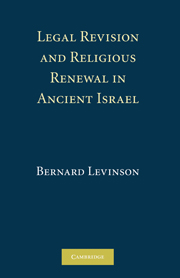Book contents
- Frontmatter
- Contents
- List of Figures
- Foreword, by Jean Louis Ska
- Preface
- Abbreviations
- 1 Biblical Studies as the Meeting Point of the Humanities
- 2 Rethinking the Relation between “Canon” and “Exegesis”
- 3 The Problem of Innovation within the Formative Canon
- 4 The Reworking of the Principle of Transgenerational Punishment: Four Case Studies
- 5 The Canon as Sponsor of Innovation
- 6 The Phenomenon of Rewriting within the Hebrew Bible: A Bibliographic Essay on Inner-Biblical Exegesis in the History of Scholarship
- Author Index
- Subject Index
- Index of Scriptural and Other Sources
5 - The Canon as Sponsor of Innovation
Published online by Cambridge University Press: 18 August 2009
- Frontmatter
- Contents
- List of Figures
- Foreword, by Jean Louis Ska
- Preface
- Abbreviations
- 1 Biblical Studies as the Meeting Point of the Humanities
- 2 Rethinking the Relation between “Canon” and “Exegesis”
- 3 The Problem of Innovation within the Formative Canon
- 4 The Reworking of the Principle of Transgenerational Punishment: Four Case Studies
- 5 The Canon as Sponsor of Innovation
- 6 The Phenomenon of Rewriting within the Hebrew Bible: A Bibliographic Essay on Inner-Biblical Exegesis in the History of Scholarship
- Author Index
- Subject Index
- Index of Scriptural and Other Sources
Summary
Textual authority was widely challenged and actively debated in ancient Israel. Yet that debate took place in textual terms. The ingenuity that, for Jonathan Z. Smith, warrants the centrality of exegesis to the study of religion thus emerges as a form of creativity that has been insufficiently recognized by the discipline of academic Religious Studies. The evidence presented here makes it possible, moreover, to enrich Smith's theoretical model by complicating its assumption of a simple priority of foundational canon to subsequent exegesis. Already evident in the wide range of texts that much later came to be selected, anthologized, and incorporated into the canon is a technical facility with texts and with interpretation. The ineluctable connection between religious renewal and textual reworking brings into clear focus the role of the technically trained scribe as the agent of cultural change. The skilled scribe is both thinker and religious visionary; spirit becomes manifest in the scribe's revision of a text. From the perspective of ancient Israel, therefore, revelation is not prior to or external to the text; revelation is in the text and of the text.
The conceptual breakthrough is grounded in the text; the originality of thought is a consequence of engagement with the textual curriculum; and the break with tradition presents itself in terms of continuity with tradition. Ingenuity here takes the form of literary sophistication: the skill by means of which successive writers were able to conceal the conflict between their new doctrine of individual retribution and the authoritative principle of transgenerational punishment.
- Type
- Chapter
- Information
- Legal Revision and Religious Renewal in Ancient Israel , pp. 89 - 94Publisher: Cambridge University PressPrint publication year: 2008



